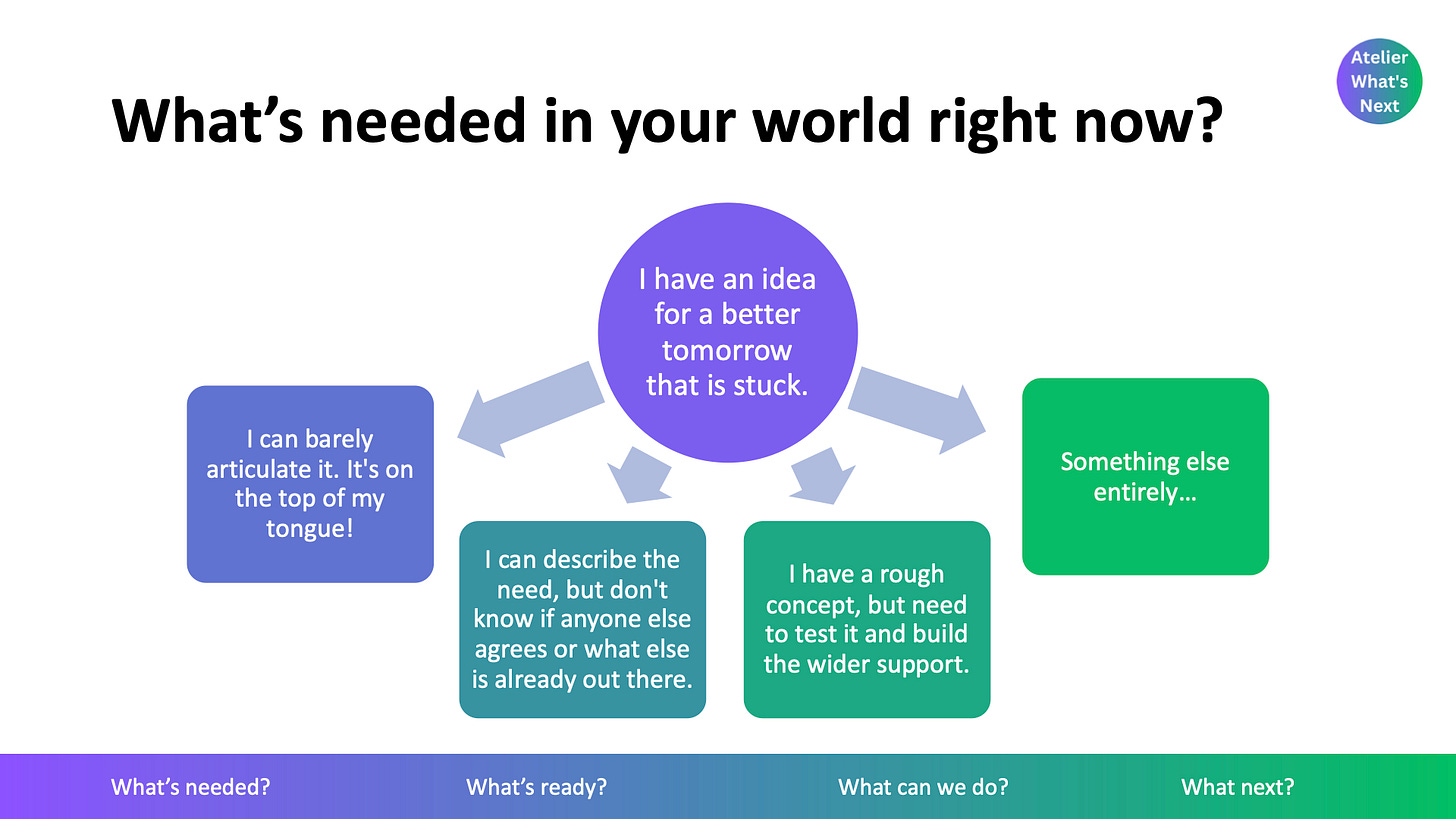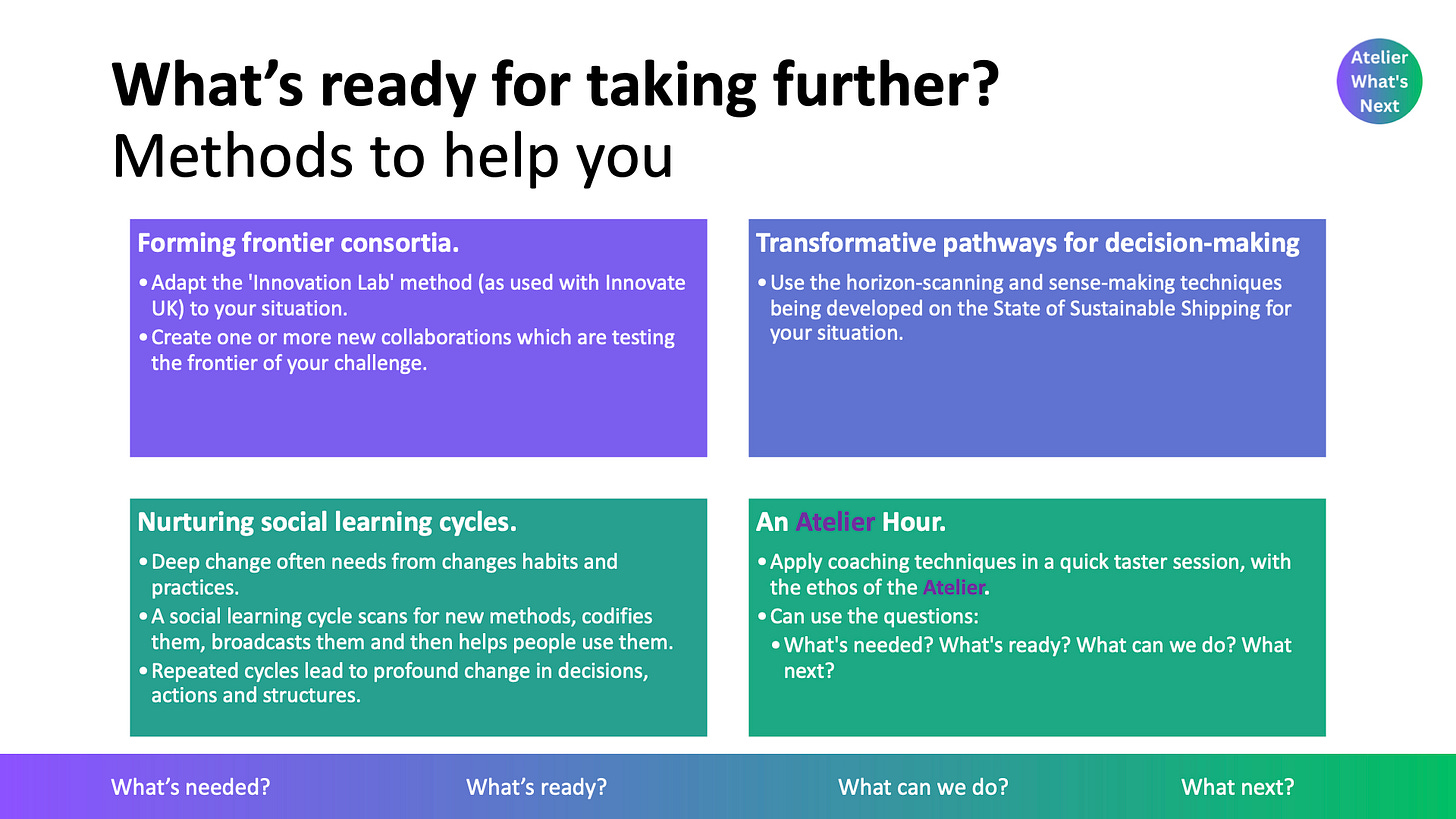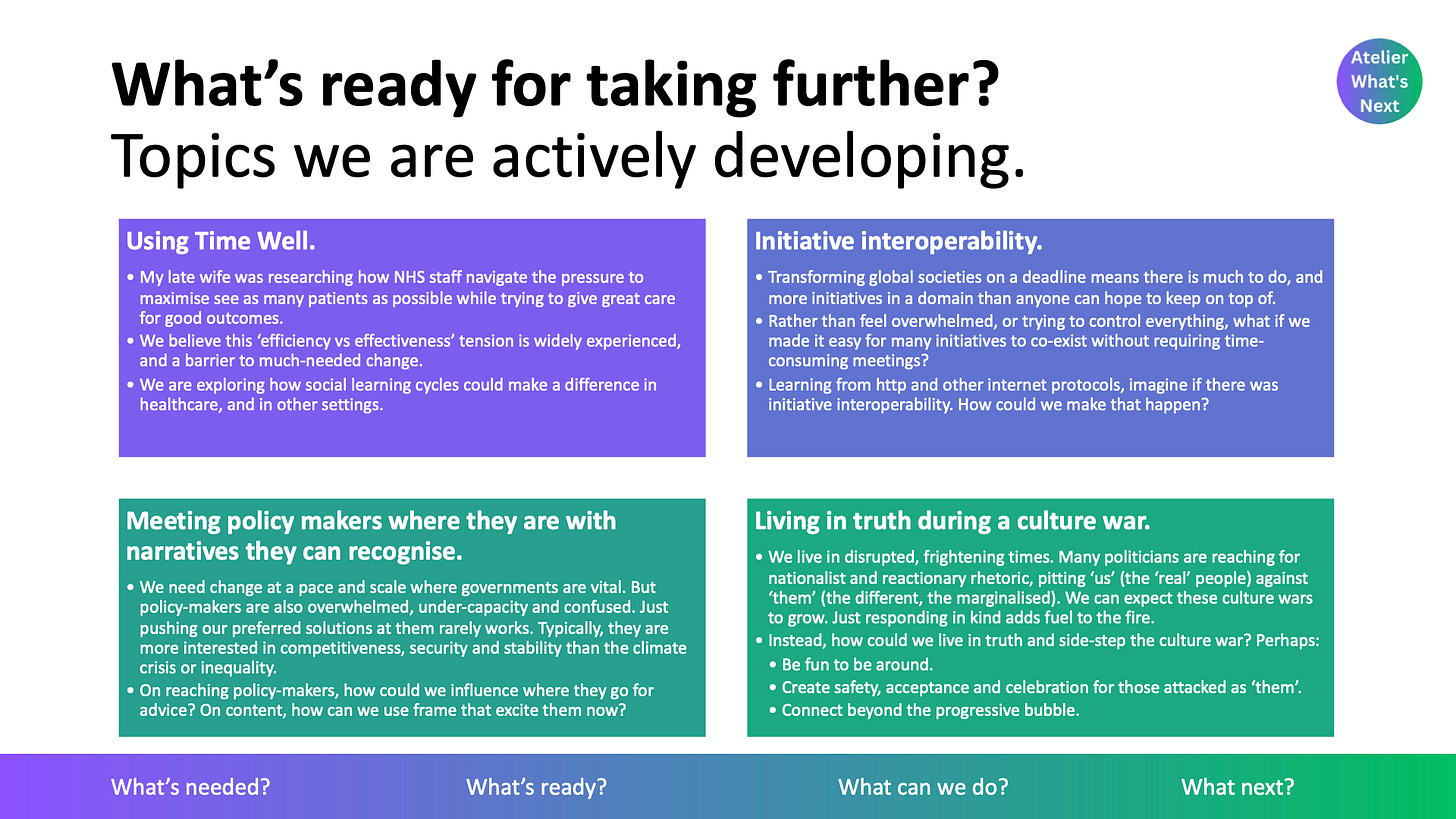Atelier WeekNotes w/c 23 Oct 2023
An introduction and invitation to the Atelier for What’s Next. Questions for postgrowth proponents.
I am writing newsletter of #weeknotes of starting the Atelier of What’s Next (What’s needed, What’s ready? What can we do? What next?). For my rationale for starting the Atelier see here.
This week covers:
An introduction and invitation to the Atelier for What’s Next
Purpose and form
Slide-by-slide commentary
Questions for postgrowth proponents.
1.How would any postgrowth economic activities out-compete currently existing economic systems?
2. How much can we know about the post-transformation world? If not much, how do we act now?
On the introduction and invitation, if you have any feedback, ideas, connections, suggestions, whatever, well, do get in touch.
Also, the end might be cut off the email (it’s hard to be fair and concise about postgrowth). So, you might need to click through to the website to read the whole thing. Enjoy! — David
Introduction and invitation
Purpose and form
Step: 2/DISCOVERING. Theme: Atelier management. Start-up.
A few weeks ago I wrote about What next for the Atelier. Things have been going OK. But I now need to move from solving my problem (how to describe and attract the work I want to do) into solving other peoples'. I set myself two questions to explore over the coming months:
What pain points do possible funders (and other resource providers) have that Atelier of What's Next could address?
How could the Atelier be organised for abundance?
The first device to explore those questions is what I've been promising for the last few WeekNotes: a slide deck that serves as an introduction and invitation. This week I finished it and have started to send it out.
I've tried to write with two audiences in mind:
Challenge-holders with something to put in the Atelier. “I have a challenge or idea for a better tomorrow which is stuck.” What next: Come into the studio for us to work on it together.
Participants who could work on stuff in the Atelier. "“I love moving challenges and ideas forward for a better tomorrow.” What next: Be part of the studio, as we help great things to happen.
Doubtless there is lots that could be improved. In the next section I will walk through the slides. If you have feedback (or a challenge that is stuck, or love to work on new things) then get in touch.
You can download the slides as a pdf directly from this link.
Slide-by-slide commentary
Title slide: How can the Atelier of What's Next be of service to you, and your purposes?
The title for the deck is very much about solving other people's problems. Bottom right unpacks the two terms which are being used a little unusually. I like that Atelier is an unusual word (it is turning into a litmus test of whether someone is curious and open, or judgemental and closed). But it does need a little explaining.
Plus I wanted to land what the studio works on. I had various iterations, but when with 'initiatives, interventions and practices'. I almost went full alliterative (all 'i', with either ideas or innovations) but do think that practices are important. The only similar term I can think of is method; neither of them being with 'i'.
A word on the slide design. There are many uses of a colour spectrum from purple to green, or (at least for me) from confused to active. This is in the bar at the bottom, and the logo (which I had to create quickly while setting up the Twitter and LinkedIn accounts). I've tried to use this range throughout, with variable results (as you will see).
Along the bottom is the tag line ('What's ready? What's needed? What can we do? What's next?'). I fear this makes all the slides busy. We'll see how people respond.
Another choice on tone of voice was using referring to the Atelier in the first person plural, "we". This felt stronger and more inclusive that "it" or "I". Again, we'll see.
Slide 2. What you can do next.
The classic thing to do here would be to hit people with the problem that needs to be solved (see Munroe Motivated Sequence). But I wanted to lead with the invitation.
Slide 3. Laying out the Atelier
This slide combines various things:
The core logic of the Atelier: we see a big need to help new things to happen; the Atelier is ready to help you act on the frontier.
The structure of the presentation, which unpacks the need, what the Atelier is for, and what we'd like to do with people.
Reinforces the tag line, as those four boxes are going through
What's needed? New things to happen.
What's ready? The Atelier of What's Next.
What can we do? Some topics and methods.
What next? Get in touch.
Again, I worry this is rather busy.
Slide 4. We've already started working at the frontier.
Reading an earlier version, I realised that it was all rather vague and hand-wavy without examples. So, I wanted to establish some specificity through stories.
The risk is people latch onto the bits they understand ('oh, so you work on shipping') rather than what I am trying to convey. Hence, each of the examples says the frontiers involved.
Slide 5. The global need…
This slide is conveying the need in the world, but in a way that the Atelier is designed to address. FOr this, I've split up the word using the Multi-Level Perspective, an "an analytical framework that provides a 'big picture,' integrative approach to understanding how transitions come about as co-evolutionary processes".
Slide 6. The Atelier is here to help on the huge challenges.
The questions at each level are effectively action research inquiry questions for the Atelier to learn from others (academics and practitioners) and to learn ourselves through trying.
Landscape. How can we accelerate deep transformations in our economies and societies towards humankind living in ways that align with nature, and where people can choose their own version of the good life?
Deep transformations is my current phrase for the depth of change we need: beyond reform but also more than radical resistance (more here).
The line on the title slide says the Atelier is acting for a 'better tomorrow'. The second half fo this question tries to define that better tomorrow. It is a combination of liberal (people can choose their own version) and, perhaps in a underhand way, Aristotelian ('good life').
Also, this is where tracking what's happening in the postgrowth field would fit (see other story in this WeekNotes).
Regime. How can we create the innovation ecosystems, political movements and appropriate governance for systemic transformation?
I'm using regime here to mean both sectors (which is the normal way of using it in MLP) and nation-states (which is a stretch, but, hey, nothing is perfect). The point here is that the deep transformation requires more than just innovation ecosystems. It also needs politics and governance.
Niches. How can we quickly learn-by-doing, in this moment, on this specific intervention, so that it thrives by accelerating shifts at the regime and landscape levels?
I'm increasingly convinced that we, as people in the world, only get to act in our 'here and now', our local time and place, our niche. How can we not be limited by that. But act in our here and now, with skill and intention to contribute up into the meso- and macro-levels?
Slide 7. What's needed by the Atelier itself?
The logic of this is to be explicit and open about what the Atelier needs. All the better to get the responses that will help (including negative respones which tell me to change my approach). Still, there's something about the language on this slide which isn't quite working for me.
But, the perfect is the enemy of the good, and I think this is a 'minimal viable product' for an invitation. (Also an example of the colour scheme not quite working.)
Slide 8. What's needed in your world right now?
Enough about the Atelier! Back to the reader and their needs!
Slide 9. What's ready for you to use or join?
This puts on one slide the top methods and topics that the Atelier would like to work on. (The next 2 slides unpack them.) Selecting these came from re-reading all the past WeekNotes, and pulling out the WHAT NEXT statements which had either a method or topic, and then prioritising within that long-list.
In the coming weeks I'm going to put up the whole list, in a way which shows the current status of each WHAT NEXT that's being considered.
Slide 10: The fundamental Atelier steps.
From the beginning, I've used the modified Double Diamond as my main framing device (see here). I'm also leaning heavily on Rowan Conway's From Design Thinking to Systems Change. The alliterative naming is all mine.
The point here is that, if someone has something they are stuck with, the first thing would be to look at which step would be most appropriate to help.
Slides 11 and 12: What's ready for taking further -- methods and topics
I have several hopes about being explicit about these:
Someone else wants to use or work on at least one of them.
They give a flavour of what I mean by an Atelier of What's Next. The range and the intent.
Slide 13: The team
Of course, right now the team is just me. Part of the intention is to invite others in. (Reader, that could be you. Do be in touch.) I wanted to make the 'space' for another co-founder very explicit.
Slide 14: Success for the Atelier on short-, medium- and long-terms
A late addition, but one that I'm pleased with. I realised the deck as it stood lacked a dream of the future (notwithstanding my scepticism of writing visions as prescriptive destinations). One way of understanding these:
Short-term: Learning by trying. Making significant progress on the two priorities: (1) the offering-challenge-resourcing fit; and (2) organising for abundance.
Medium-term: Thriving by doing-and-learning. A successful Atelier.
Long-term: Contributing to a better future. Trying to be inspirational and also humble (whatever else, the Atelier is not the Main Character in this movie we call life). Hence, making a contribution. The three bullets are the answers to the three questions back on slide 6, at the landscape, regime and niche levels.
Slides 15 and 16: Reinforcing the invitation
Because you need to tell the audience what you're going to tell them, tell them, and then tell them what you told them.
WHAT NEXT
Start to engage people.
Get feedback on the deck.
Start getting interest in the methods or topics, or being part of the Atelier. Hopefully.
Start doing other things that address the priorities of: (1) the offering-challenge-resourcing fit; and (2) organising for abundance. The main idea here is to have co-badged events exploring what's needed and what's ready.
Questions for postgrowth proponents.
Step: 2/DISCOVERING. Theme: Societal transformation.
In the week I went to a lecture on "Postgrowth – strategies and challenges for change" with Prof Milena Buchs, hosted by the Political Economy Research Centre (PERC) of Goldsmiths College.
Prof Buchs gave a 40 minute overview of the why, what and how of postgrowth, both the current literature and the recent research she has been doing on postgrowth in practice.
There's far too much there for me to summarise (sorry) but it did prompt some questions in me:
1.How would any postgrowth economic activities out-compete currently existing economic systems?
Our world today is dominate by capitalism, or rather by a variety of capitalisms (from state-managed through social democratic to nigh-on laissaez-faire). Yes, there are parts of countries and parts of the world which have not fully joined in with a capitalist accumulation logic. But these are weak, compared to the mainstream economy, even if they are really important (for instance, the proportion of biodiversity that it effectively under the management of indigenous peoples).
Over the last, say, 250 years, the success of capitalism has come from having a variety of forms, each of which has outcompeted whatever else was around. Maslin and Lewis in The Human Planet use this vastly over-simplified schematic to represent that history:
The point is that all the different varieties of capitalism have an inner dynamic which creates the conditions for more success. (1) You invest 'capital' (yes, money, but really know-how, machinery, organisations, infrastructure and other resources) into an activity. (2) Do well enough to accumulate more capital for the next cycle. (3) Also, have incentivised and orientated the world around you just a little bit towards what you need. (4) Invest again, with more capital and with more of the world around you set up for your success. Repeat millions of times.
That's the flywheel of capitalisms. Historically, they outcompete the alternatives (again, very simplistically: fuedalism, communism, communitarianism, etc). Those are pushed to the margins, if they survive at all. Or, more often, they are enclosed or coopted ("They're selling hippie wigs in Woolworth's, man. The greatest decade in mankind's history is over" -- Withnail and I).
To restate my question in those terms: what are the possible flywheels in any of the 'postgrowth' alternatives which can outcompete the currently existing economic systems? Whether the postgrowth has to be postcapitalist, or could be yet another form of capitalism, what will mean it causes resources to shift over to being used in its cycle of success on its own terms?
2. How much can we know about the post-transformation world? If not much, how do we act now?
For me, a lot of the postgrowth strategies described in the talk assume that we can know and control the process and stable destination of what happens next.
Even though the 'process' is an unprecedented set of global, interacting forces across social, economic and natural dimensions which take us out of the societal form we have been used to for centuries. And, even though the 'destination' is a something that folks across the postgrowth field people don't agree on in detail.
Of course, that's one of the reasons it is an umbrella term characterised by what it is after (post-X) rather than by what it is for. As with 'Brexit', lots of people can agree on what they dislike but not on what they would do next.
(For what it's worth, I am for variety of views, especially when faced with unprecedented situations. Vareity gives us more options. I'm against believing that because a large group being against X, therefore everyone in the group wants the same things to happen. See: how the pro-Brexit coalition has splintered since the referendum.)
I'm deeply sceptical about what we can know, especially if it is truly a deep transformation, then the categories of thought we have available now will be obsolete once we get there. What would the leading monks of 1250CE have predicted for the coming centuries? Not the Renaissance or the start of (mercantile) capitalism.
So, I'm deeply sceptical that we can know it will be post-growth, or post-capitalist. (As it happens, given the ability of capitalisms to adapt in the face of long duree pressures, I'm more inclined to believe that what happens next will be a new set of capitalisms, ones which can increase in the financial value of activities without causing irreversible harm to people or planet. But that's a secondary point. The primary point is the epistemological and ontological uncertainty embedded in our situation: We. Just. Can't. Know.)
Hence, I'm sceptical of the use in writing ever-more detailed visions or models of post-these-capitalisms. Those tell us more about the values of the writers (who rarely represent a range of of values even from with their own settings) than it does about the available futures, or how we get there.
All of this is why, in the UCL talk I gave back in March I tried to describe a direction to get us started. One which accepted our situation as a predicament to be lived (rather than a problem to be solved), and that we face deep uncertainty, then the thing to do is to set a direction for action and values to inform the choices along the way.
This diagram summarises where I got to. It is wrong, but hopefully useful. I still haven't written it up properly (busy idiot that I am). I write about the direction in a previous WeekNote here. You can find the slides with more of the argument that gets to this point here.
WHAT NEXT
Despite my scepticism, the postgrowth field deserves attention as one of the places which is trying to engage with the theory and practice of transformation.




















